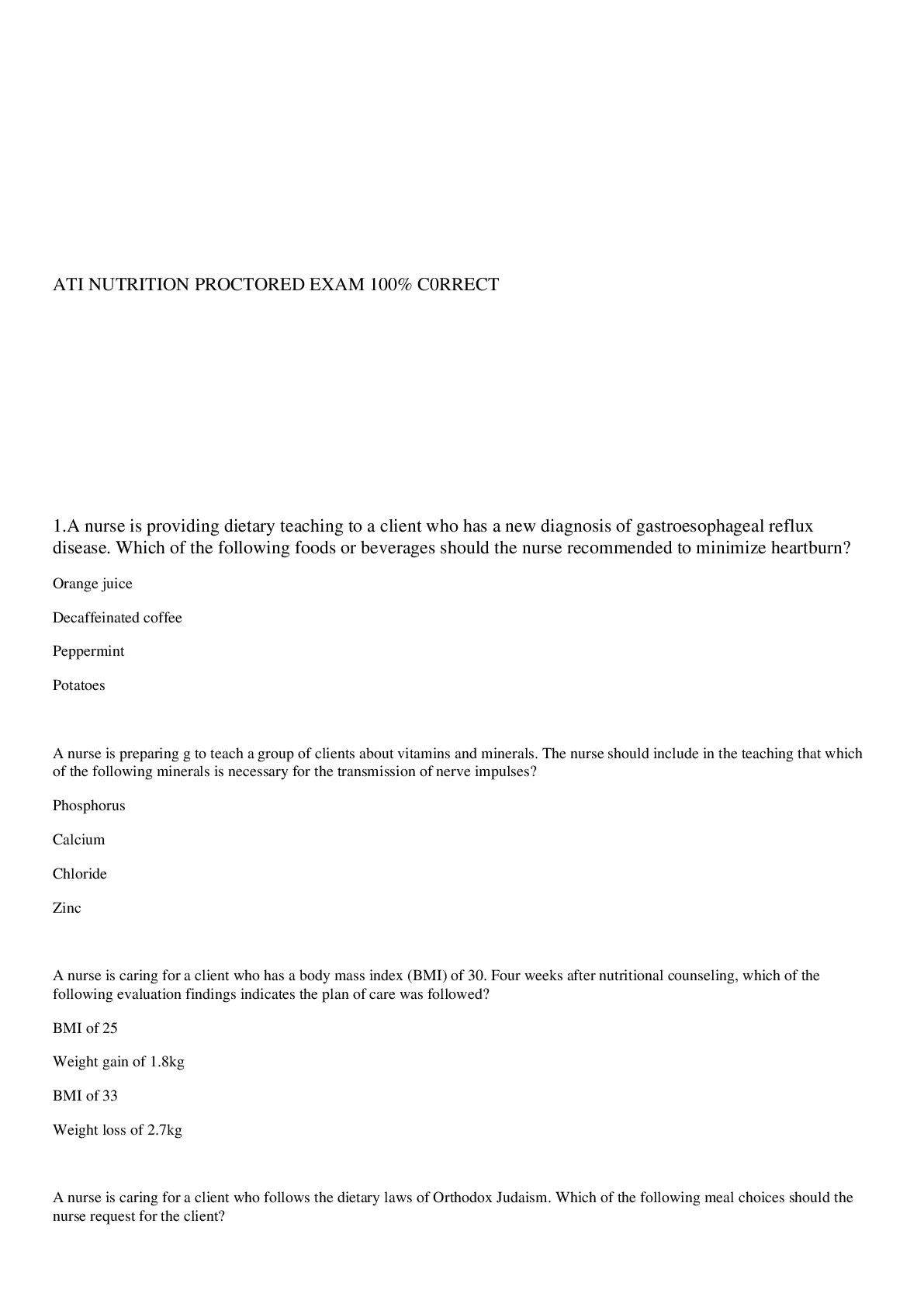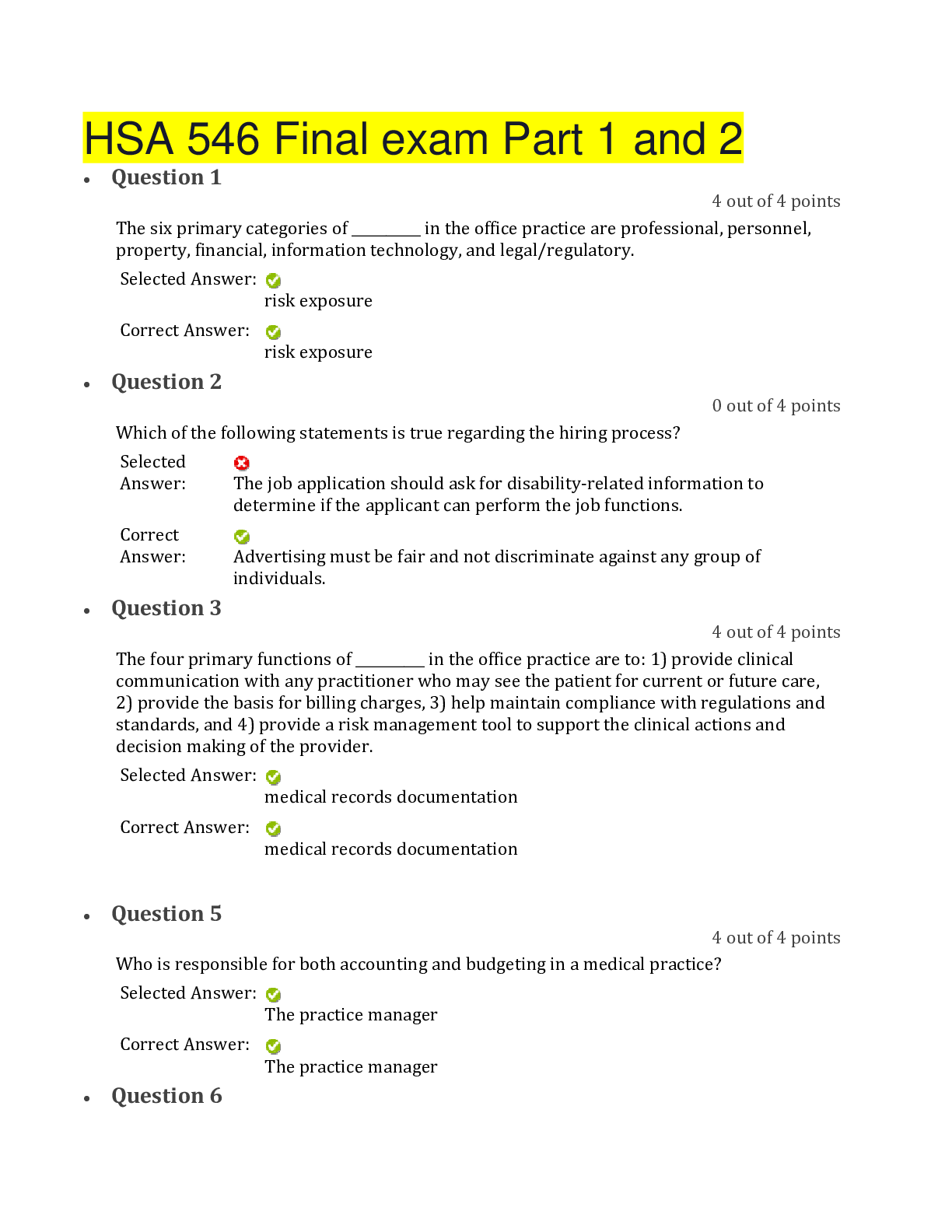Health Care > EXAM > NR 341 QUESTIONS AND ANSWERS 100% CORRECT-Chamberlain College of Nursing (All)
NR 341 QUESTIONS AND ANSWERS 100% CORRECT-Chamberlain College of Nursing
Document Content and Description Below
1)A patient is recovering from transphenoidal surgery for partial resection of a pituitary adenoma. The nurse should caution the patient NOT to do which of the following? A) Blow his nose or sneeze ... B) Deep breathe C) Drink more than 2 liters of fluid a day D) Sit up in bed higher than 30 degrees Answer: A Explanation: A) These activities may cause the patch to dislodge which could result in a cerebrospinal fluid leak (CSF) and increase the risk of infection. #2 is incorrect. Deep breathing is a post- operative activity that all post - op patients should perform to prevent atelectasis. Coughing would be contraindicated in this patient as is would raise intracranial pressure. #3 is incorrect. Drinking 2 liters of fluid per day is a post - op activity that helps the body metabolize anesthesia, maintains hydration and liquefies pulmonary secretions. #4 is incorrect. The head of the beds needs to be elevated at least 30 degreeshigher to reduce post - op edema. This also allows for better lung expansion to prevent atelectasis. Nursing Process: Intervention Cognitive Level: Application Category of Need: Physiological Integrity–Reduction of Risk Potential B)These activities may cause the patch to dislodge which could result in a cerebrospinal fluid leak (CSF) and increase the risk of infection. #2 is incorrect. Deep breathing is a post- operative activity that all post - op patients should perform to prevent atelectasis. Coughing would be contraindicated in this patient as is would raise intracranial pressure. #3 is incorrect. Drinking 2 liters of fluid per day is a post - op activity that helps the body metabolize anesthesia, maintains hydration and liquefies pulmonary secretions. #4 is incorrect. The head of the beds needs to be elevated at least 30 degreeshigher to reduce post - op edema. This also allows for better lung expansion to prevent atelectasis. Nursing Process: Intervention Cognitive Level: Application Category of Need: Physiological Integrity–Reduction of Risk Potential C) These activities may cause the patch to dislodge which could result in a cerebrospinal fluid leak (CSF) and increase the risk of infection. #2 is incorrect. Deep breathing is a post- operative activity that all post - op patients should perform to prevent atelectasis. Coughing would be contraindicated in this patient as is would raise intracranial pressure. #3 is incorrect. Drinking 2 liters of fluid per day is a post - op activity that helps the body metabolize anesthesia, maintains hydration and liquefies pulmonary secretions. #4 is incorrect. The head of the beds needs to be elevated at least 30 degreeshigher to reduce post - op edema. This also allows for better lung expansion to prevent atelectasis. Nursing Process: Intervention Cognitive Level: Application Category of Need: Physiological Integrity–Reduction of Risk Potential 1 NR 341 QUESTIONS AND ANSWERS 100% CORRECT D) These activities may cause the patch to dislodge which could result in a cerebrospinal fluid leak (CSF) and increase the risk of infection. #2 is incorrect. Deep breathing is a post- operative activity that all post - op patients should perform to prevent atelectasis. Coughing would be contraindicated in this patient as is would raise intracranial pressure. #3 is incorrect. Drinking 2 liters of fluid per day is a post - op activity that helps the body metabolize anesthesia, maintains hydration and liquefies pulmonary secretions. #4 is incorrect. The head of the beds needs to be elevated at least 30 degreeshigher to reduce post - op edema. This also allows for better lung expansion to prevent atelectasis. Nursing Process: Intervention Cognitive Level: Application Category of Need: Physiological Integrity–Reduction of Risk Potential 2)A patient is diagnosed with a grade II astrocytoma. The nurse realizes that this patient's prognosis is: A) Excellent. B)Good as long as the tumor is treated soon. C) Good because the tumor is well defined. D) Poor because the tumor cells are irregularly shaped. Answer: B Explanation: A) Astrocytomas are the most common types of primary brain tumor, and are graded from I to IV according to tissue histology. Grade I and grade II tumors are considered to be low- grade tumors and have the most favorable survival rates and respond favorably to early treatment. #3 is incorrect. Grade I tumor cells are well defined and almost normallshaped. They have a low incidence of brain infiltration. Grade II tumor cells are less well defined and there is the possibility that a grade II tumor will transform to a higher grade#4 is not correct. Higher - grade (III and IV) tumor cells are abnormally shaped and have a pronounced ability to infiltrate normal brain tissue, therefore the prognosis is poor. #1 is not correct. Excellent prognosis is not associated with this type of brain tumor Cognitive Level: Analysis Nursing Process: Assessment Category of Need: Physiological Integrity–Reduction of Risk Potential B) Astrocytomas are the most common types of primary brain tumor, and are graded from I to IV according to tissue histology. Grade I and grade II tumors are considered to be low- grade tumors and have the most favorable survival rates and respond favorably to early treatment. #3 is incorrect. Grade I tumor cells are well defined and almost normallshaped. They have a low incidence of brain infiltration. Grade II tumor cells are less well defined and there is the possibility that a grade II tumor will transform to a higher grade#4 is not correct. Higher - grade (III and IV) tumor cells are abnormally shaped and have a pronounced ability to infiltrate normal brain tissue, therefore the prognosis is poor. #1 is not correct. Excellent prognosis is not associated with this type of brain tumor Cognitive Level: Analysis Nursing Process: Assessment Category of Need: Physiological Integrity–Reduction of Risk Potential 2 C) Astrocytomas are the most common types of primary brain tumor, and are graded from I to IV according to tissue histology. Grade I and grade II tumors are considered to be low- grade tumors and have the most favorable survival rates and respond favorably to early treatment. #3 is incorrect. Grade I tumor cells are well defined and almost normallshaped. They have a low incidence of brain infiltration. Grade II tumor cells are less well defined and there is the possibility that a grade II tumor will transform to a higher grade#4 is not correct. Higher - grade (III and IV) tumor cells are abnormally shaped and have a pronounced ability to infiltrate normal brain tissue, therefore the prognosis is poor. #1 is not correct. Excellent prognosis is not associated with this type of brain tumor Cognitive Level: Analysis Nursing Process: Assessment Category of Need: Physiological Integrity–Reduction of Risk Potential D) Astrocytomas are the most common types of primary brain tumor, and are graded from I to IV according to tissue histology. Grade I and grade II tumors are considered to be low- grade tumors and have the most favorable survival rates and respond favorably to early treatment. #3 is incorrect. Grade I tumor cells are well defined and almost normallshaped. They have a low incidence of brain infiltration. Grade II tumor cells are less well defined and there is the possibility that a grade II tumor will transform to a higher grade#4 is not correct. Higher - grade (III and IV) tumor cells are abnormally shaped and have a pronounced ability to infiltrate normal brain tissue, therefore the prognosis is poor. #1 is not correct. Excellent prognosis is not associated with this type of brain tumor Cognitive Level: Analysis Nursing Process: Assessment Category of Need: Physiological Integrity–Reduction of Risk Potential 3)The nurse is assessing a patient with a meningioma. The nurse realizes that this patient will have: A) A hearing disorder. B) A life expectancy of about 10 months. C) An excellent prognosis if the tumor is totally removed. D) Metastasis to other body organs. Answer: C Explanation: A) The most common benign brain tumors arise from the meninges and are called meningiomas. They are usually well circumscribed, may be attached to the dura, and areassociated with an excellent prognosis when gross - total resection is possible. #1 is not correct. Other common benign brain tumors arise from nerve sheaths as with acoustic neuromas which can lead to a hearing loss. A noncancerous primary brain tumor may be life threatening if it compromises a vital structure or undergoes malignant transformation. #2 is not correct. Meningiomas are usually benign and do not affect life expectancy. #4 is not correct. Meningiomas are encapsulated and benign therefore do not metastasize to other organs. Cognitive Level: Analysis Nursing Process: Assessment Category of Need: Physiological Integrity–Reduction of Risk Potential 3 B)The most common benign brain tumors arise from the meninges and are called meningiomas. They are usually well circumscribed, may be attached to the dura, and areassociated with an excellent prognosis when gross - total resection is possible. #1 is not correct. Other common benign brain tumors arise from nerve sheaths as with acoustic neuromas which can lead to a hearing loss. A noncancerous primary brain tumor may be life threatening if it compromises a vital structure or undergoes malignant transformation. #2 is not correct. Meningiomas are usually benign and do not affect life expectancy. #4 is not correct. Meningiomas are encapsulated and benign therefore do not metastasize to other organs. Cognitive Level: Analysis Nursing Process: Assessment Category of Need: Physiological Integrity–Reduction of Risk Potential C) The most common benign brain tumors arise from the meninges and are called meningiomas. They are usually well circumscribed, may be attached to the dura, and areassociated with an excellent prognosis when gross - total resection is possible. #1 is not correct. Other common benign brain tumors arise from nerve sheaths as with acoustic neuromas which can lead to a hearing loss. A noncancerous primary brain tumor may be life threatening if it compromises a vital structure or undergoes malignant transformation. #2 is not correct. Meningiomas are usually benign and do not affect life expectancy. #4 is not correct. Meningiomas are encapsulated and benign therefore do not metastasize to other organs. Cognitive Level: Analysis Nursing Process: Assessment Category of Need: Physiological Integrity–Reduction of Risk Potential D) The most common benign brain tumors arise from the meninges and are called meningiomas. They are usually well circumscribed, may be attached to the dura, and areassociated with an excellent prognosis when gross - total resection is possible. #1 is not correct. Other common benign brain tumors arise from nerve sheaths as with acoustic neuromas which can lead to a hearing loss. A noncancerous primary brain tumor may be life threatening if it compromises a vital structure or undergoes malignant transformation. #2 is not correct. Meningiomas are usually benign and do not affect life expectancy. #4 is not correct. Meningiomas are encapsulated and benign therefore do not metastasize to other organs. Cognitive Level: Analysis Nursing Process: Assessment Category of Need: Physiological Integrity–Reduction of Risk Potential 4)A patient with increased intracranial pressure is diagnosed with a brain tumor. The nurse realizes that this patient most likely has: A) An astrocytoma. B) A meningioma. C) A tumor less than 1 mm in size. D) A tumor greater than 1 mm in size. Answer: D 4 Explanation: A) Brain tumors appear to cause symptoms by different mechanisms. One mechanism is the development of cerebral edema. Cerebral edema appears to develop once tumors have increased in size beyond 1 mm. The new blood vessels that feed the tumor lack the normal blood- brain barrier and are more permeable to macromolecules, proteins, and ions, resulting in vasogenic cerebral edema. Simultaneously, macrophages and inflammatory mediators that increase vascular permeability and edema are released. #1 is not correct. Astrocytoma are grade I and II tumors that grow slowly and the first is symptoms are seizures. A late symptom is increased intracranial pressure. #2 is not correct. Meningioma are extremely slow growing tumors there is a low incidence of the development of increased intracranial pressure. #3 is not correct. Tumors of less than 1 mm in size do not result in the development of cerebral edema as there is minimal displacement of cerebral tissue. Cognitive Level: Analysis Nursing Process: Assessment Category of Need: Physiological Integrity–Reduction of Risk Potential B) Brain tumors appear to cause symptoms by different mechanisms. One mechanism is the development of cerebral edema. Cerebral edema appears to develop once tumors have increased in size beyond 1 mm. The new blood vessels that feed the tumor lack the normal blood- brain barrier and are more permeable to macromolecules, proteins, and ions, resulting in vasogenic cerebral edema. Simultaneously, macrophages and inflammatory mediators that increase vascular permeability and edema are released. #1 is not correct. Astrocytoma are grade I and II tumors that grow slowly and the first is symptoms are seizures. A late symptom is increased intracranial pressure. #2 is not correct. Meningioma are extremely slow growing tumors there is a low incidence of the development of increased intracranial pressure. #3 is not correct. Tumors of less than 1 mm in size do not result in the development of cerebral edema as there is minimal displacement of cerebral tissue. Cognitive Level: Analysis Nursing Process: Assessment Category of Need: Physiological Integrity–Reduction of Risk Potential C) Brain tumors appear to cause symptoms by different mechanisms. One mechanism is the development of cerebral edema. Cerebral edema appears to develop once tumors have increased in size beyond 1 mm. The new blood vessels that feed the tumor lack the normal blood- brain barrier and are more permeable to macromolecules, proteins, and ions, resulting in vasogenic cerebral edema. Simultaneously, macrophages and inflammatory mediators that increase vascular permeability and edema are released. #1 is not correct. Astrocytoma are grade I and II tumors that grow slowly and the first is symptoms are seizures. A late symptom is increased intracranial pressure. #2 is not correct. Meningioma are extremely slow growing tumors there is a low incidence of the development of increased intracranial pressure. #3 is not correct. Tumors of less than 1 mm in size do not result in the development of cerebral edema as there is minimal displacement of cerebral tissue. Cognitive Level: Analysis Nursing Process: Assessment Category of Need: Physiological Integrity–Reduction of Risk Potential 5 D) Brain tumors appear to cause symptoms by different mechanisms. One mechanism is the development of cerebral edema. Cerebral edema appears to develop once tumors have increased in size beyond 1 mm. The new blood vessels that feed the tumor lack the normal blood- brain barrier and are more permeable to macromolecules, proteins, and ions, resulting in vasogenic cerebral edema. Simultaneously, macrophages and inflammatory mediators that increase vascular permeability and edema are released. #1 is not correct. Astrocytoma are grade I and II tumors that grow slowly and the first is symptoms are seizures. A late symptom is increased intracranial pressure. #2 is not correct. Meningioma are extremely slow growing tumors there is a low incidence of the development of increased intracranial pressure. #3 is not correct. Tumors of less than 1 mm in size do not result in the development of cerebral edema as there is minimal displacement of cerebral tissue. Cognitive Level: Analysis Nursing Process: Assessment Category of Need: Physiological Integrity–Reduction of Risk Potential 5)An elderly patient is not concerned that he has a brain tumor because he has not had any headaches, only a slight increase in forgetfulness. The nurse realizes that this patient most likely: A) Does not have a brain tumor because brain tumors rarely present with cognitive changes. B) Does not have a tumor because forgetfulness is seen in children with a brain tumor. C) Could have a brain tumor even though he does not have a headache. D) Has the beginnings of Alzheimer's disease. Answer: C Explanation: A) Because older adults have age - related brain atrophy, they are less likely to present with generalized symptom [Show More]
Last updated: 1 year ago
Preview 1 out of 36 pages
 (1).png)
Reviews( 0 )
Document information
Connected school, study & course
About the document
Uploaded On
Sep 13, 2022
Number of pages
36
Written in
Additional information
This document has been written for:
Uploaded
Sep 13, 2022
Downloads
0
Views
40

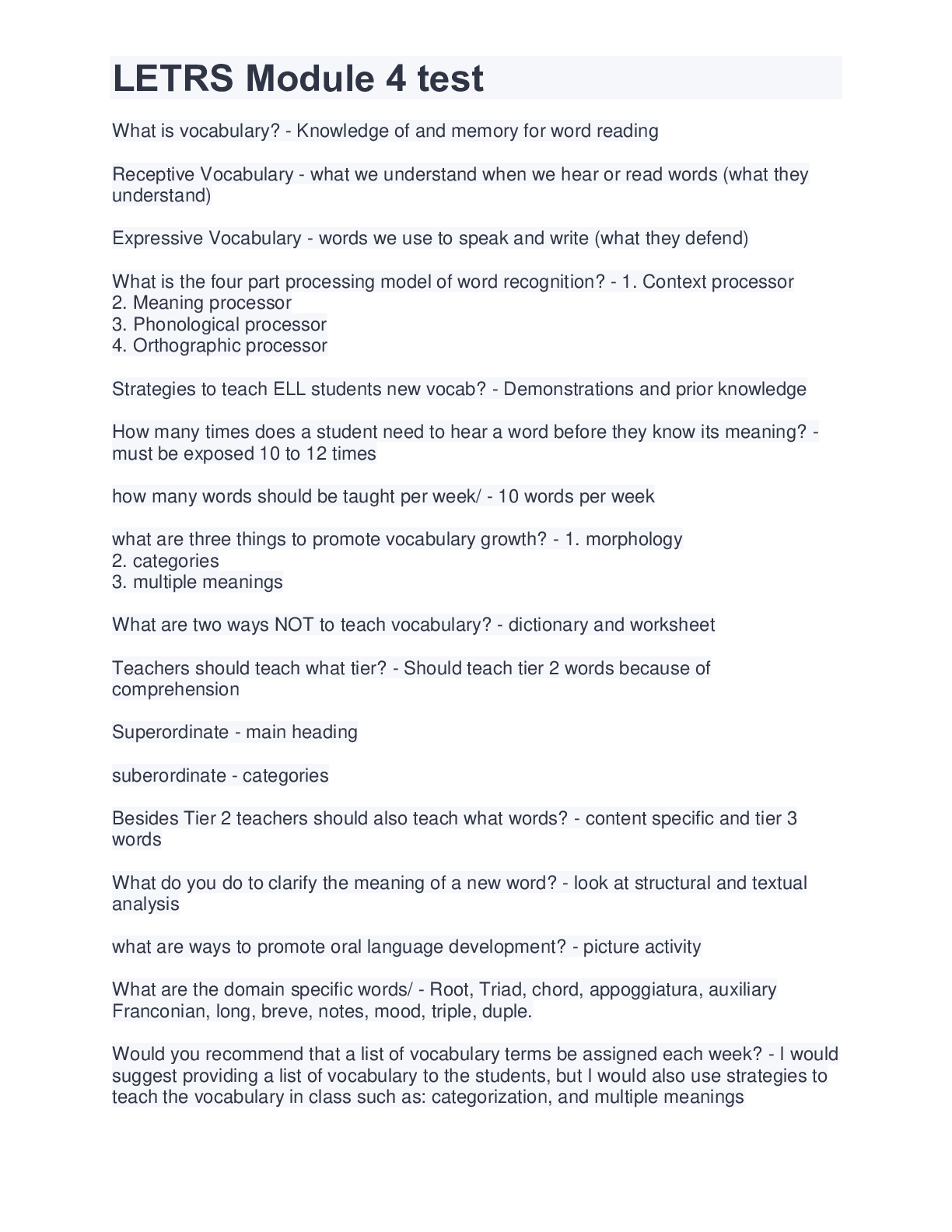
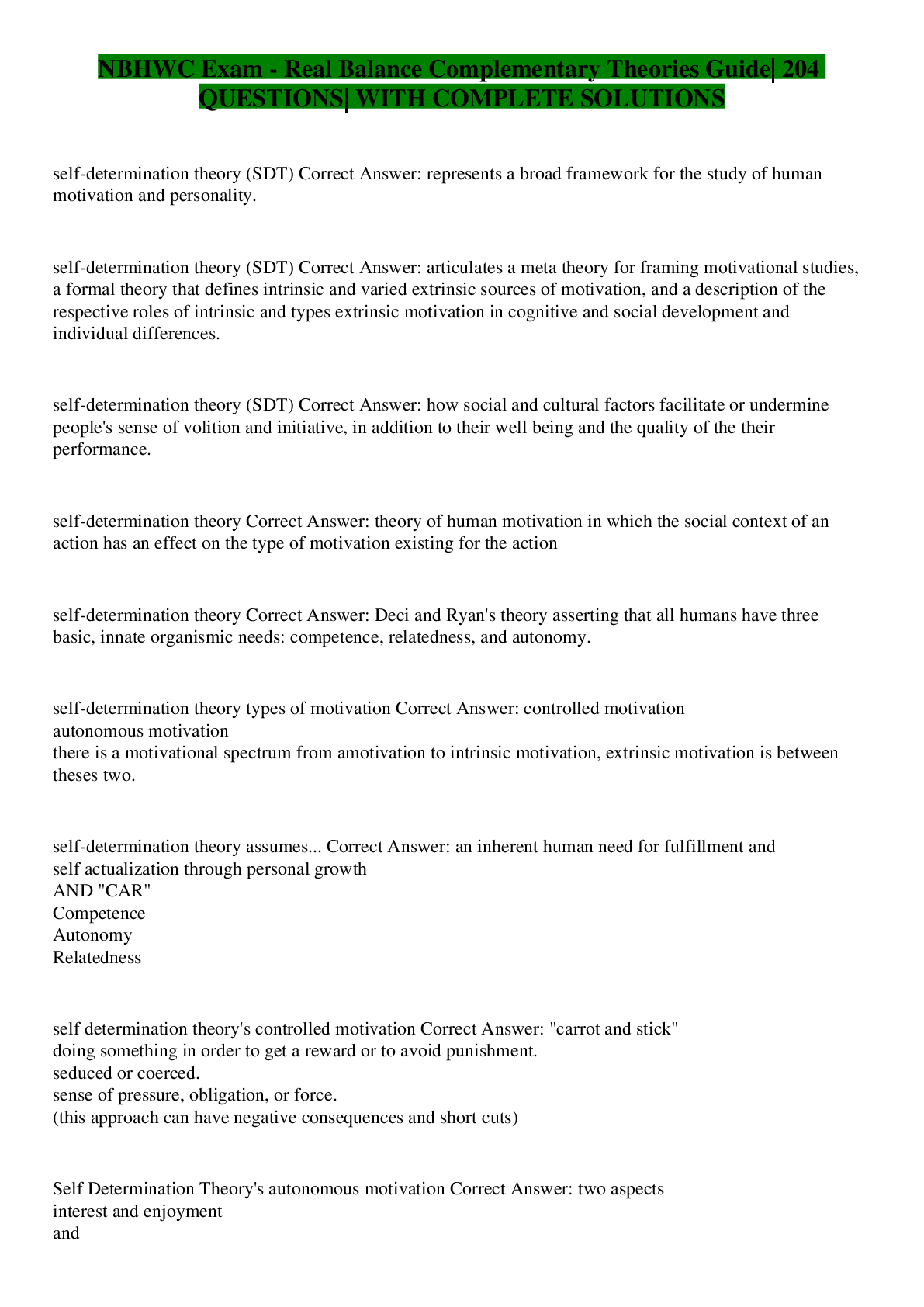
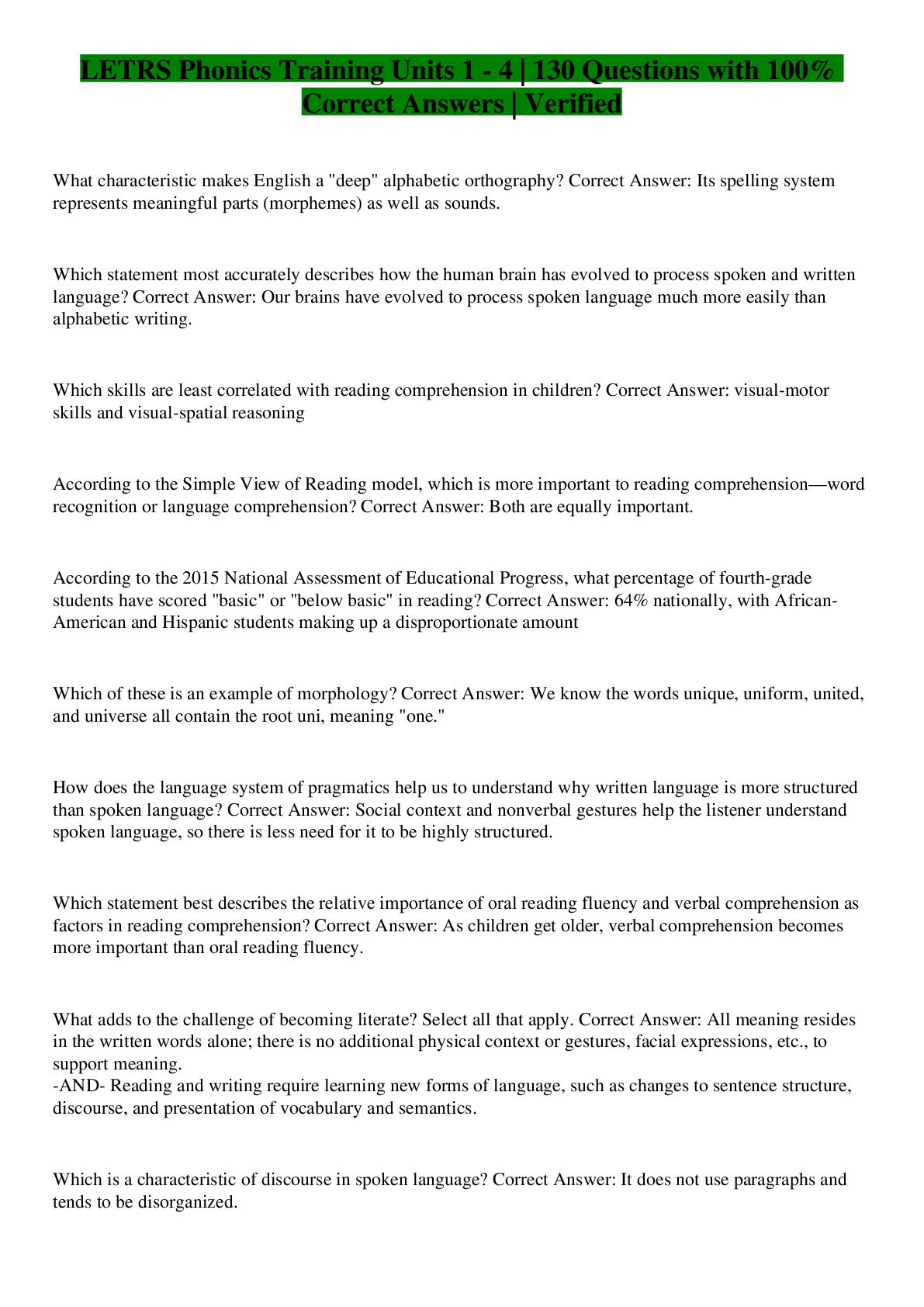

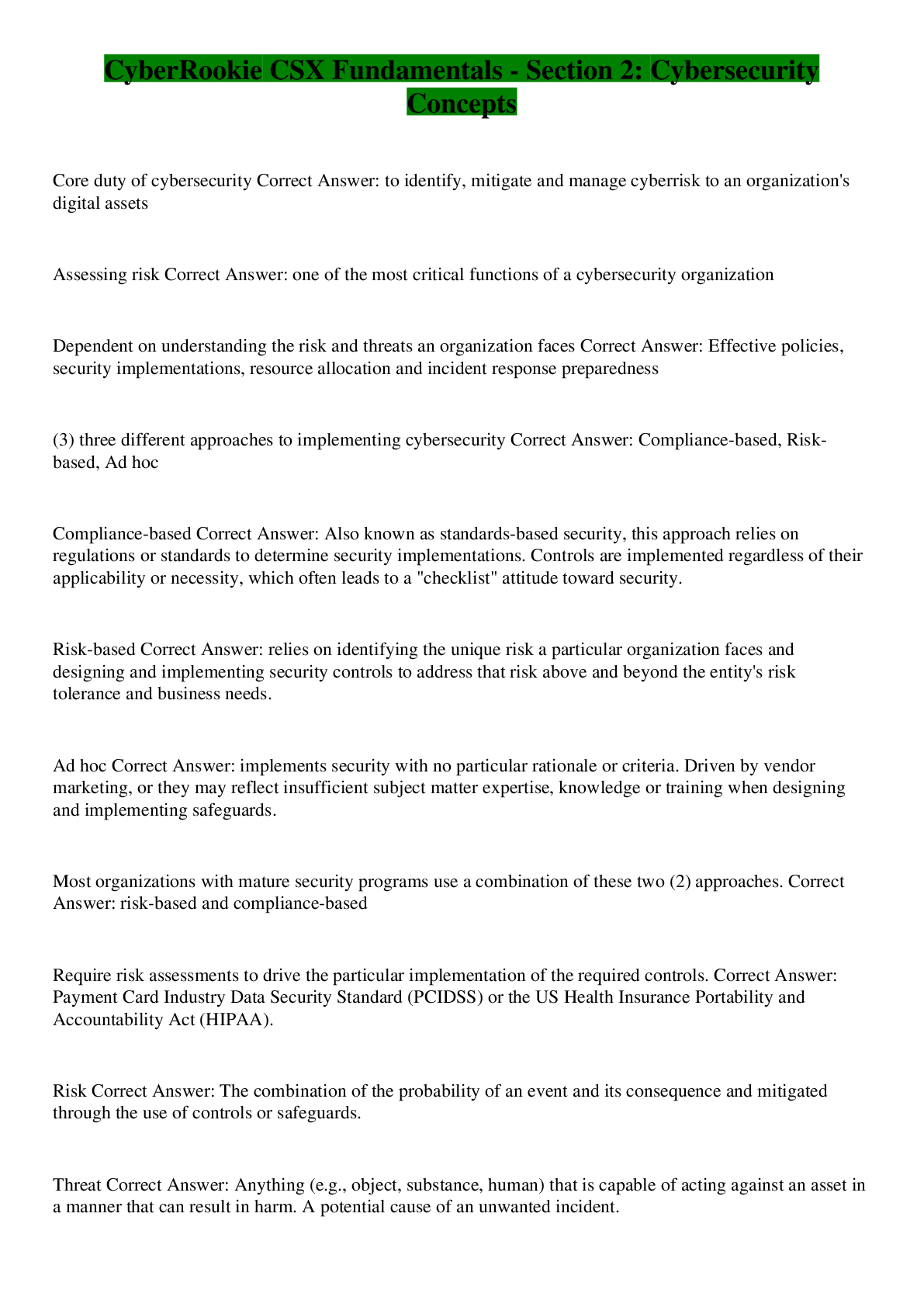
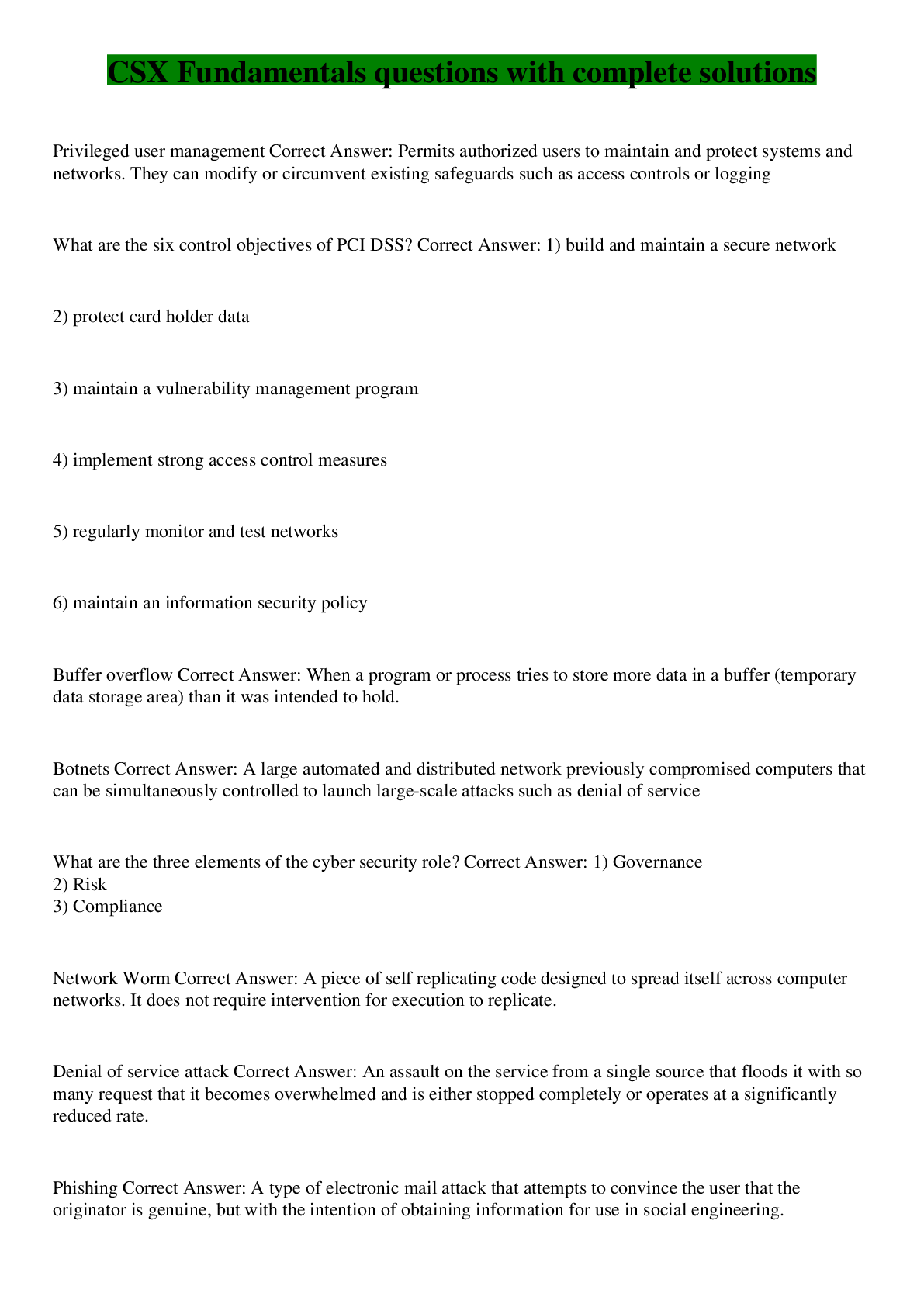

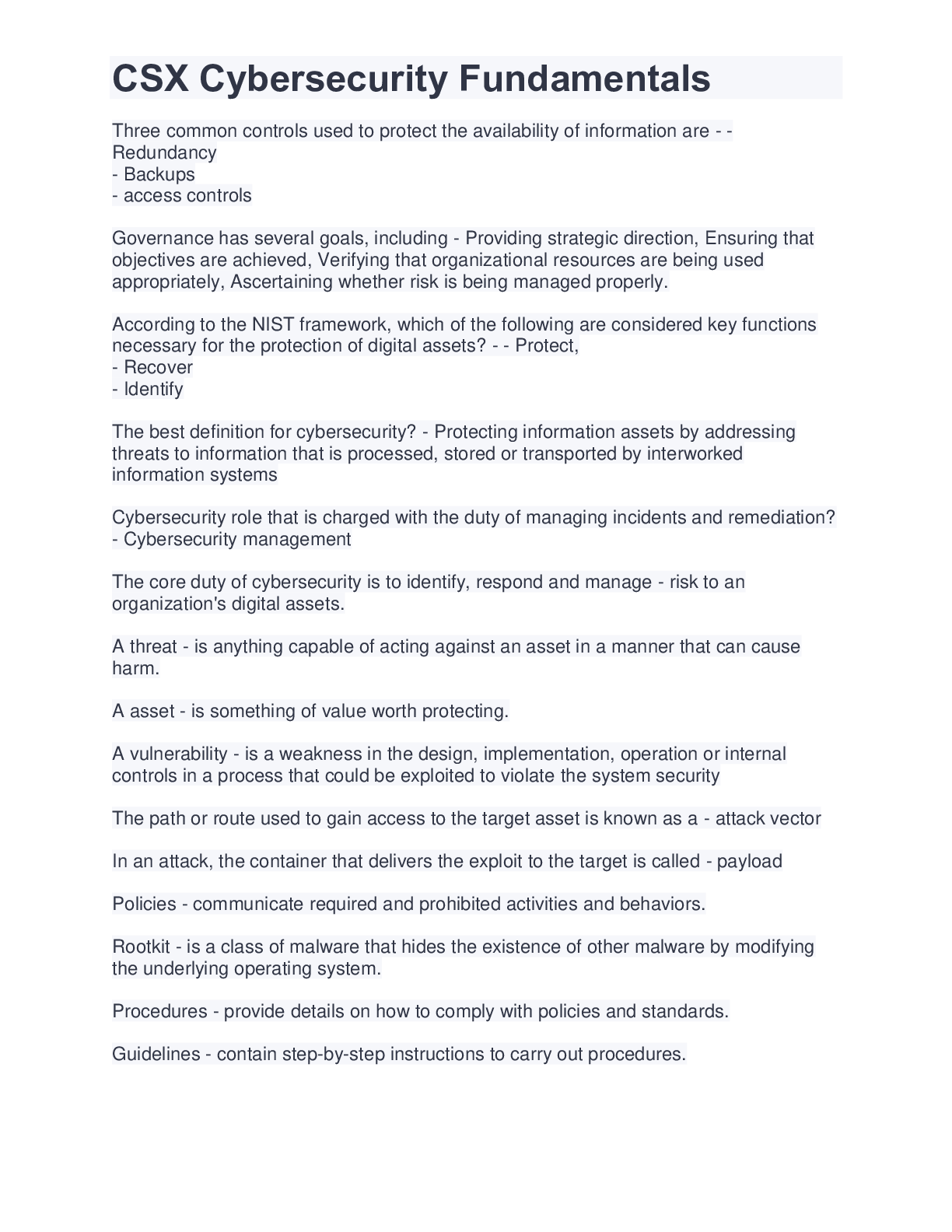



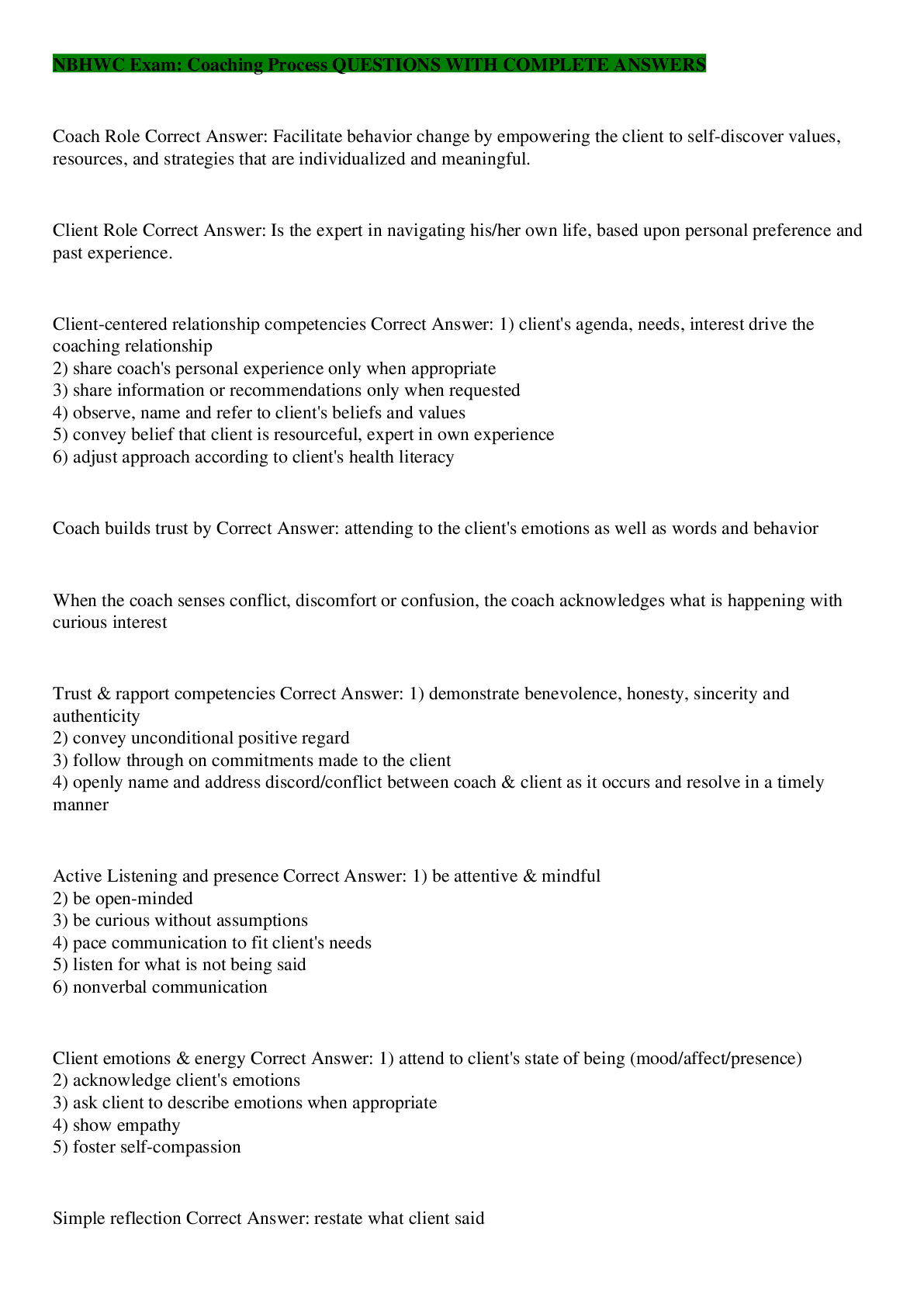
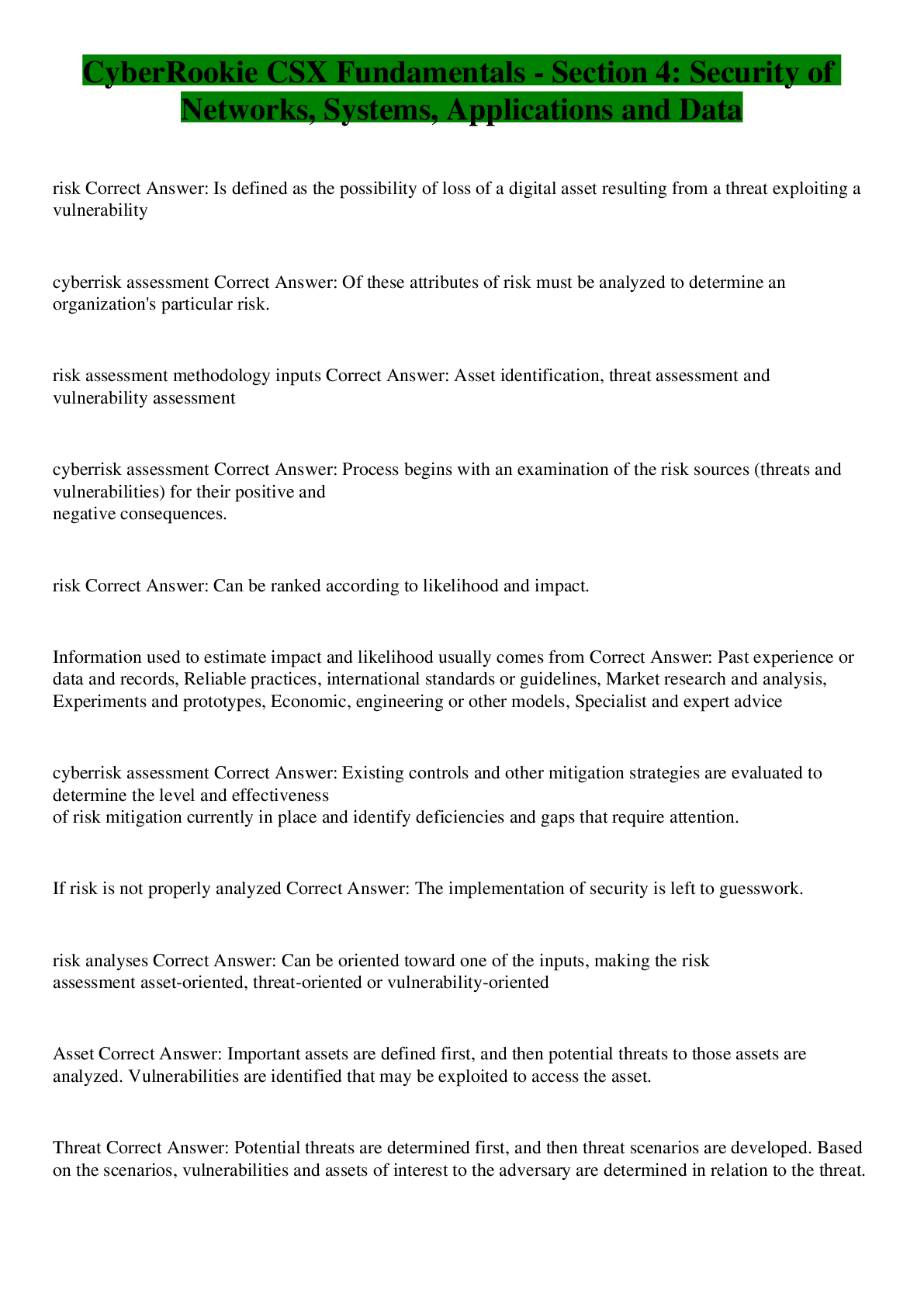
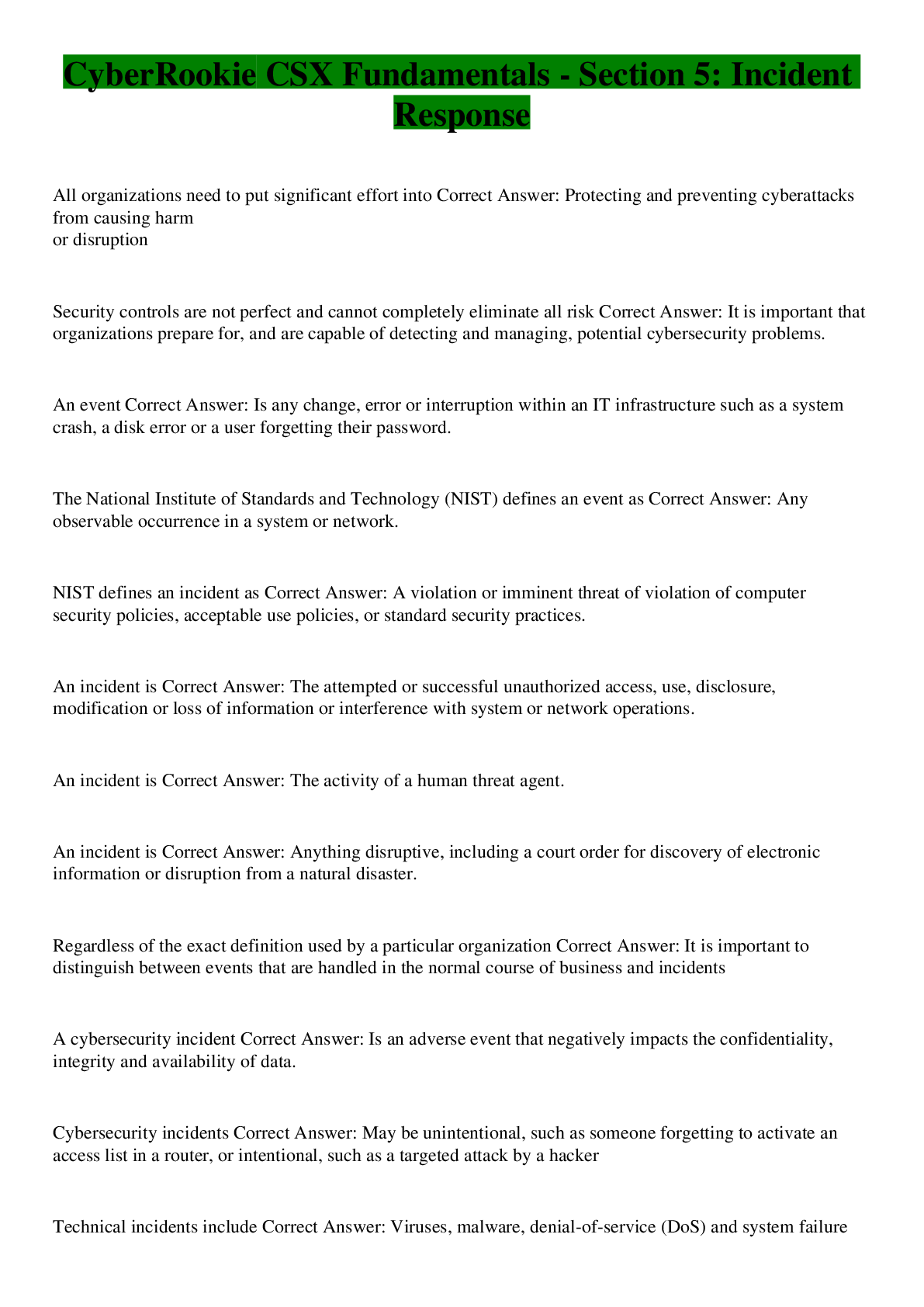
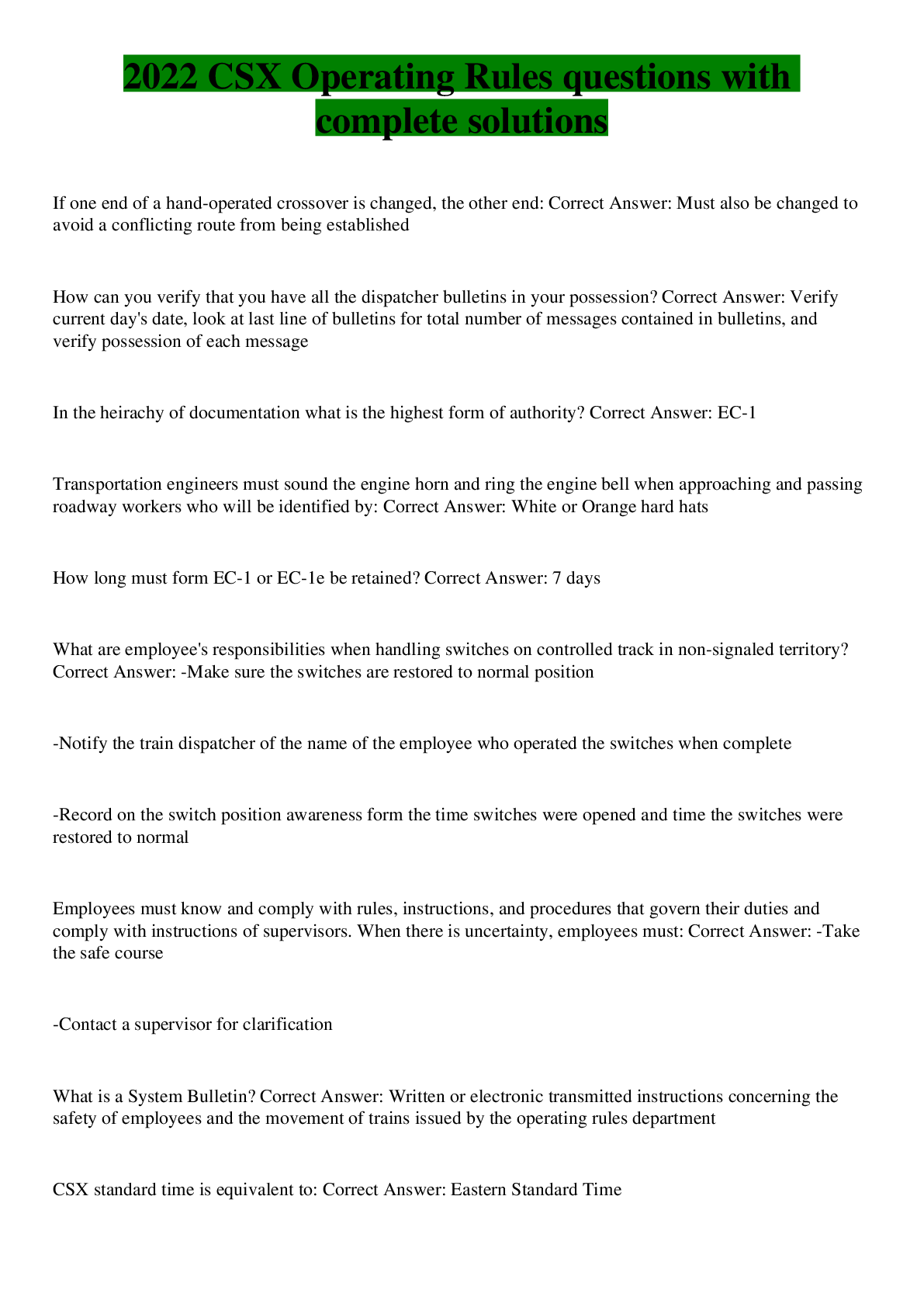
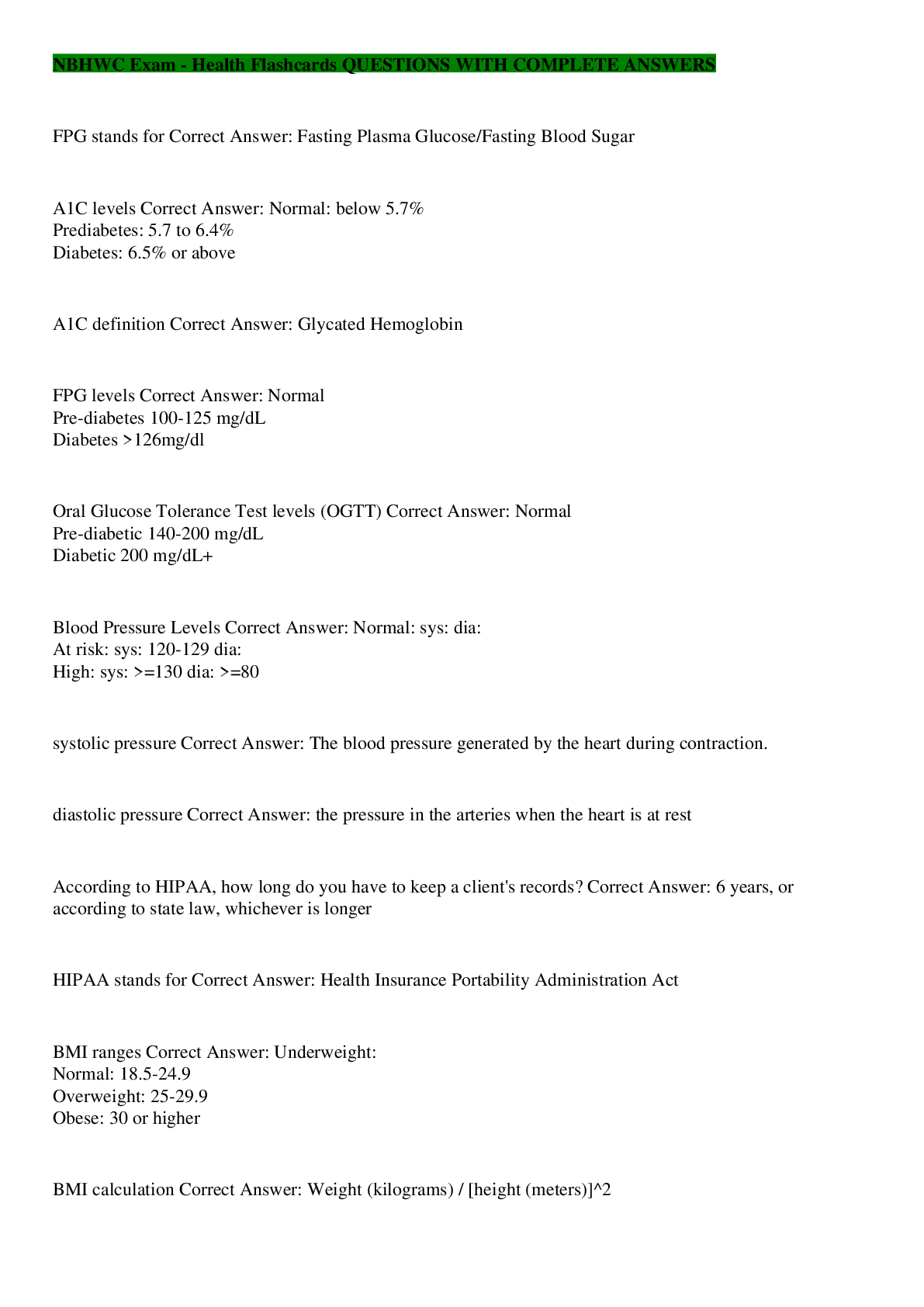

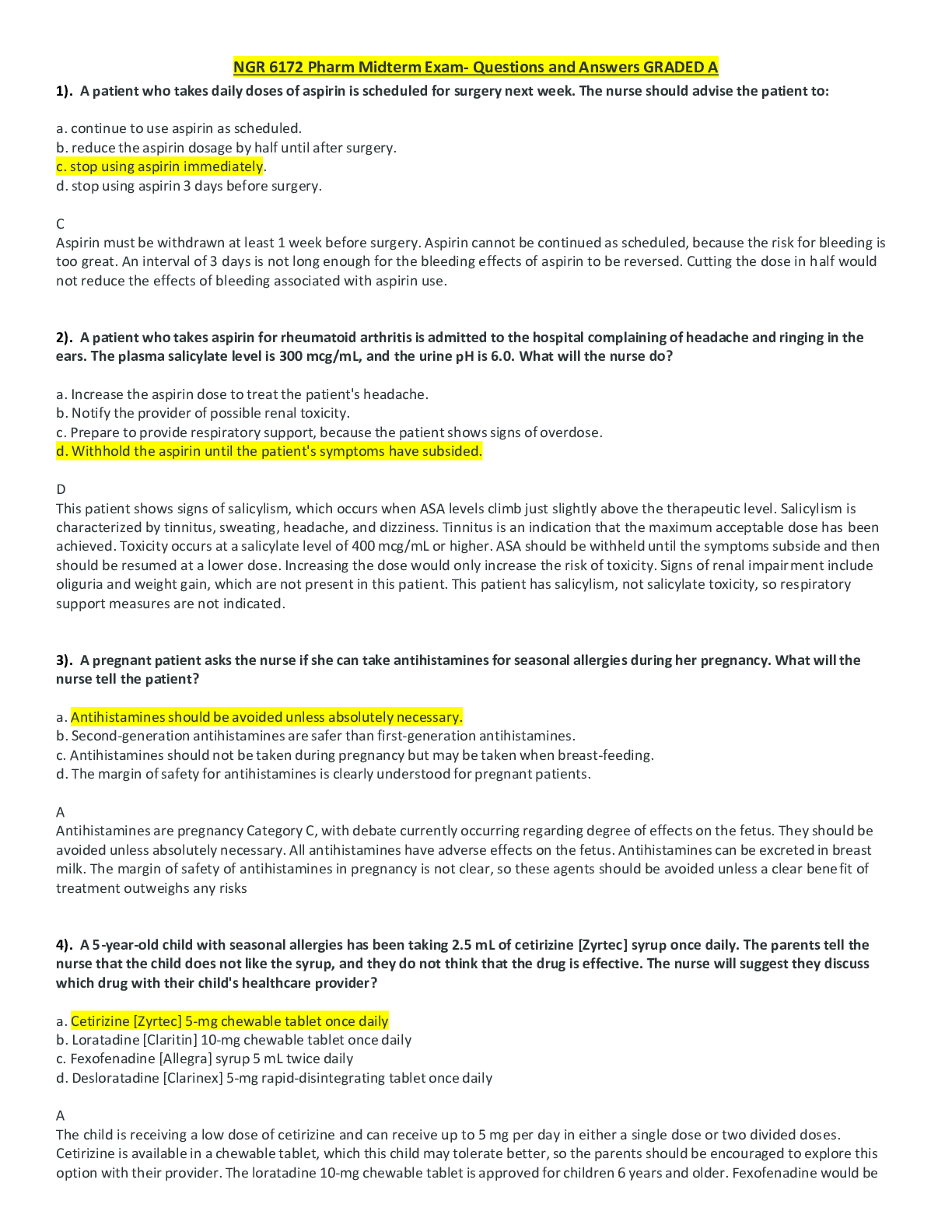


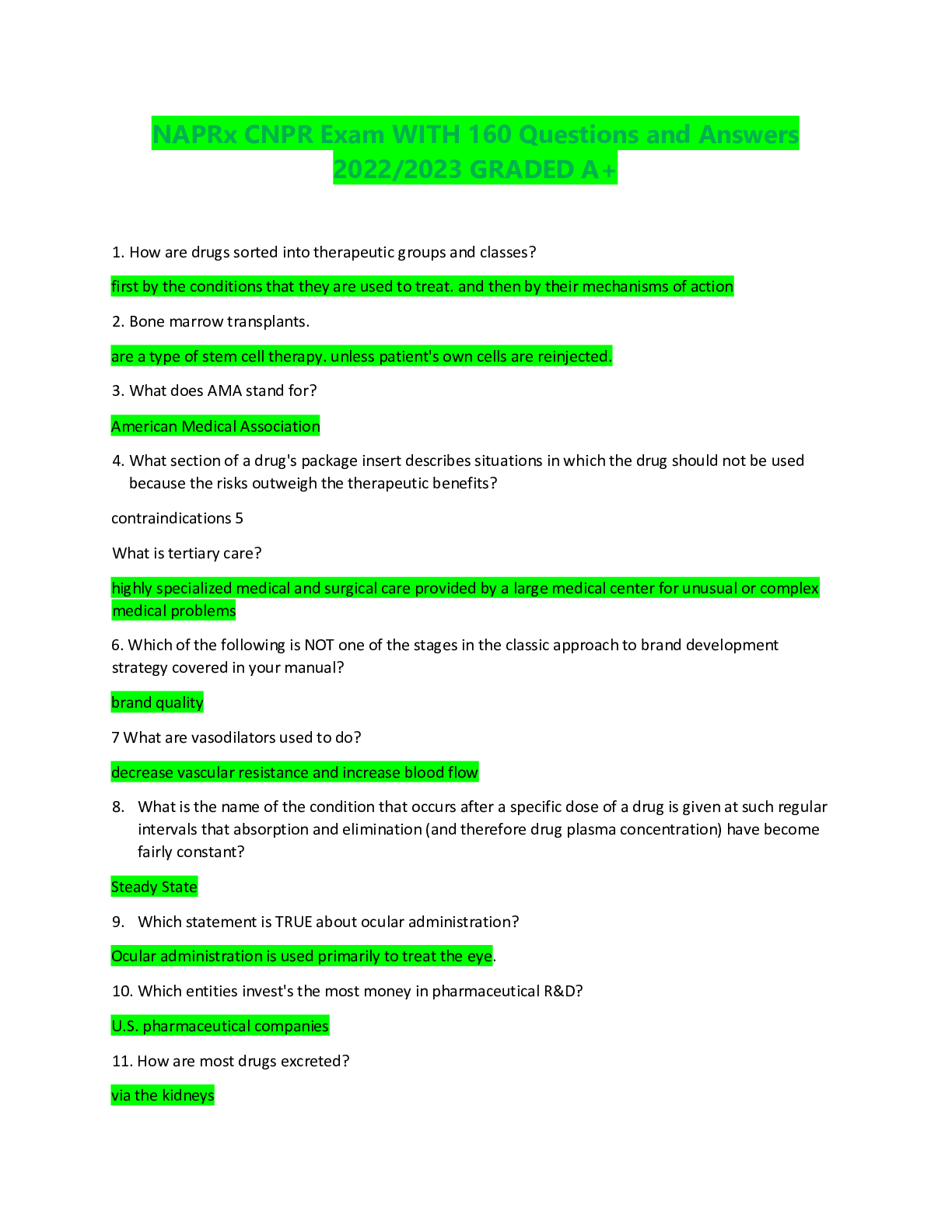
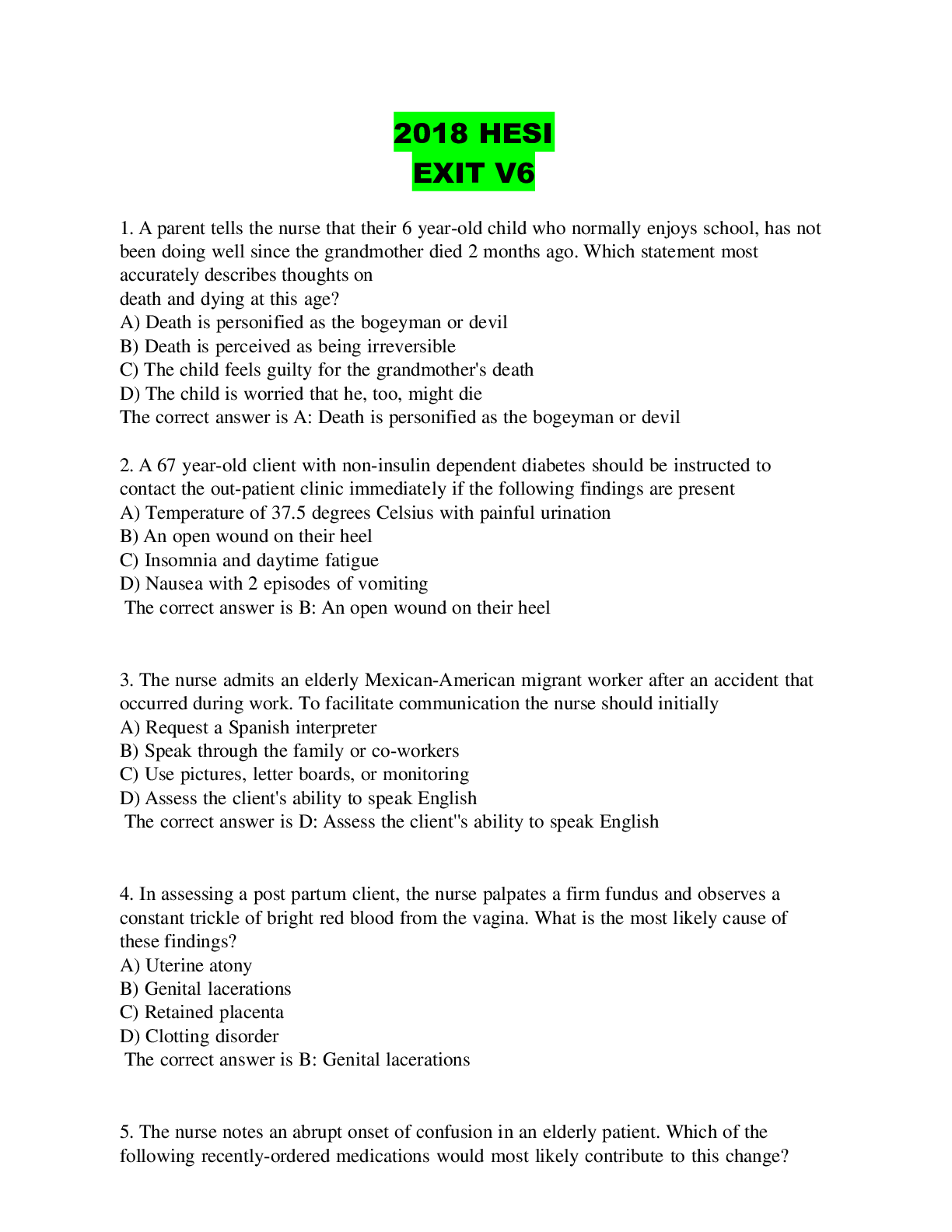
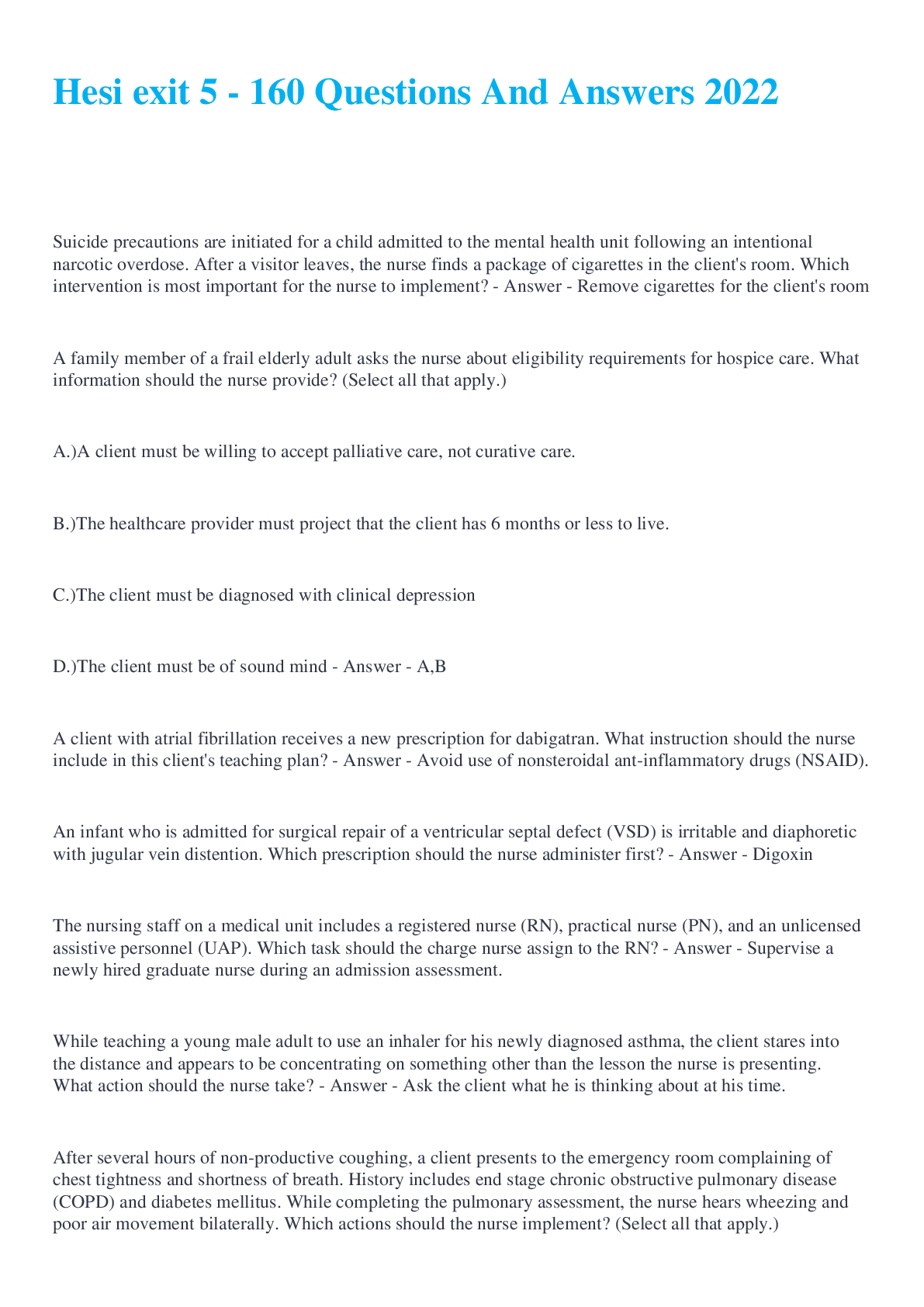
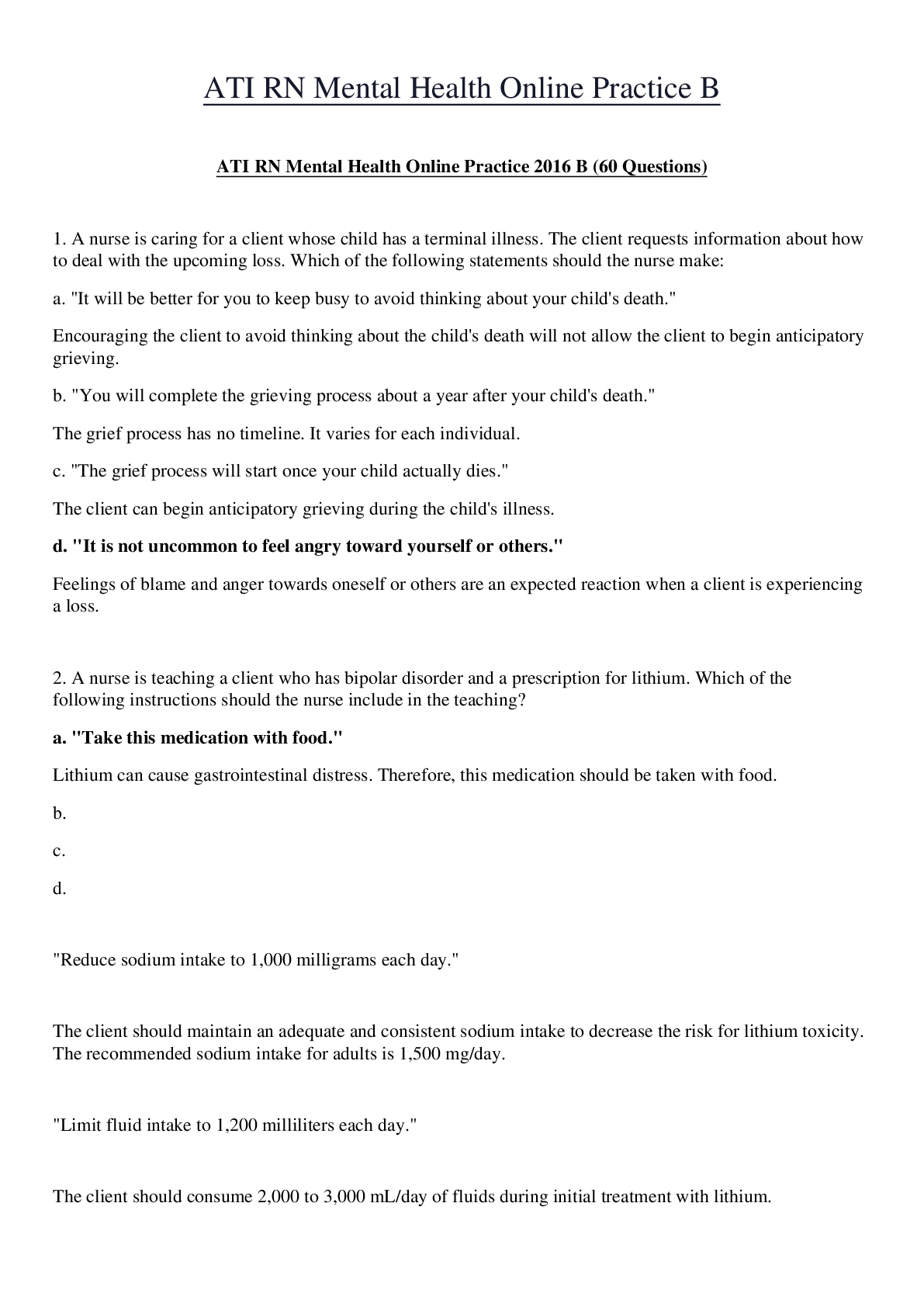
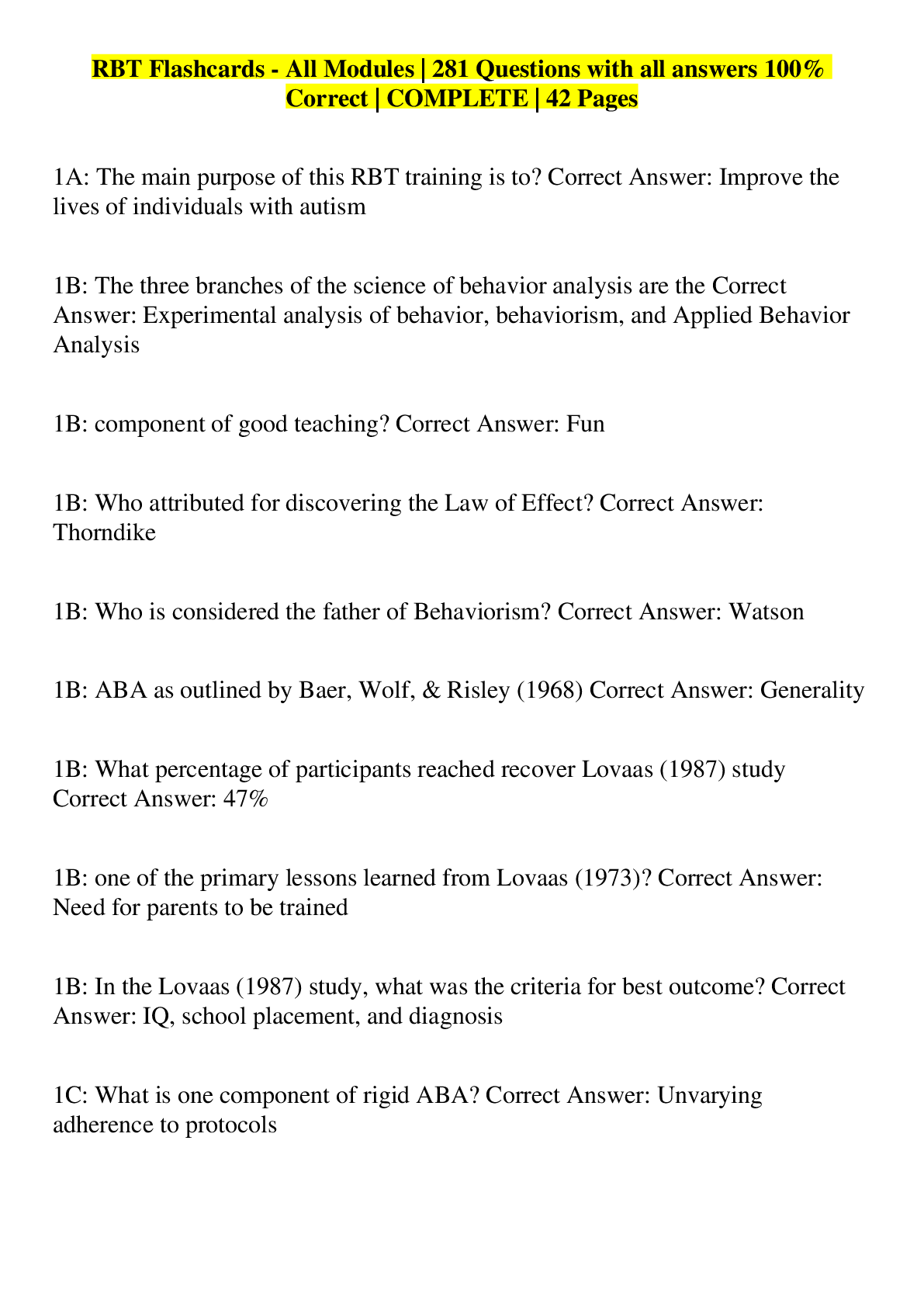

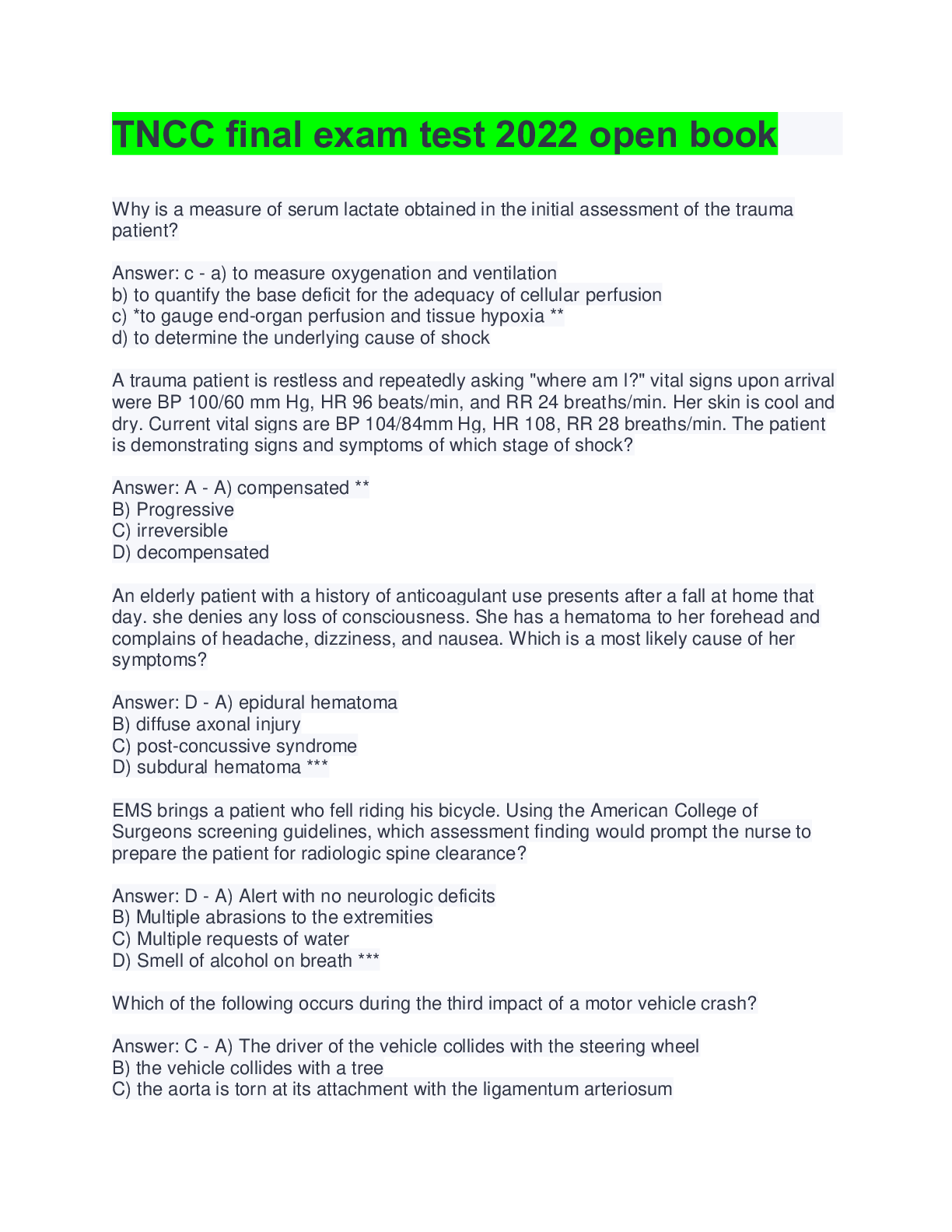

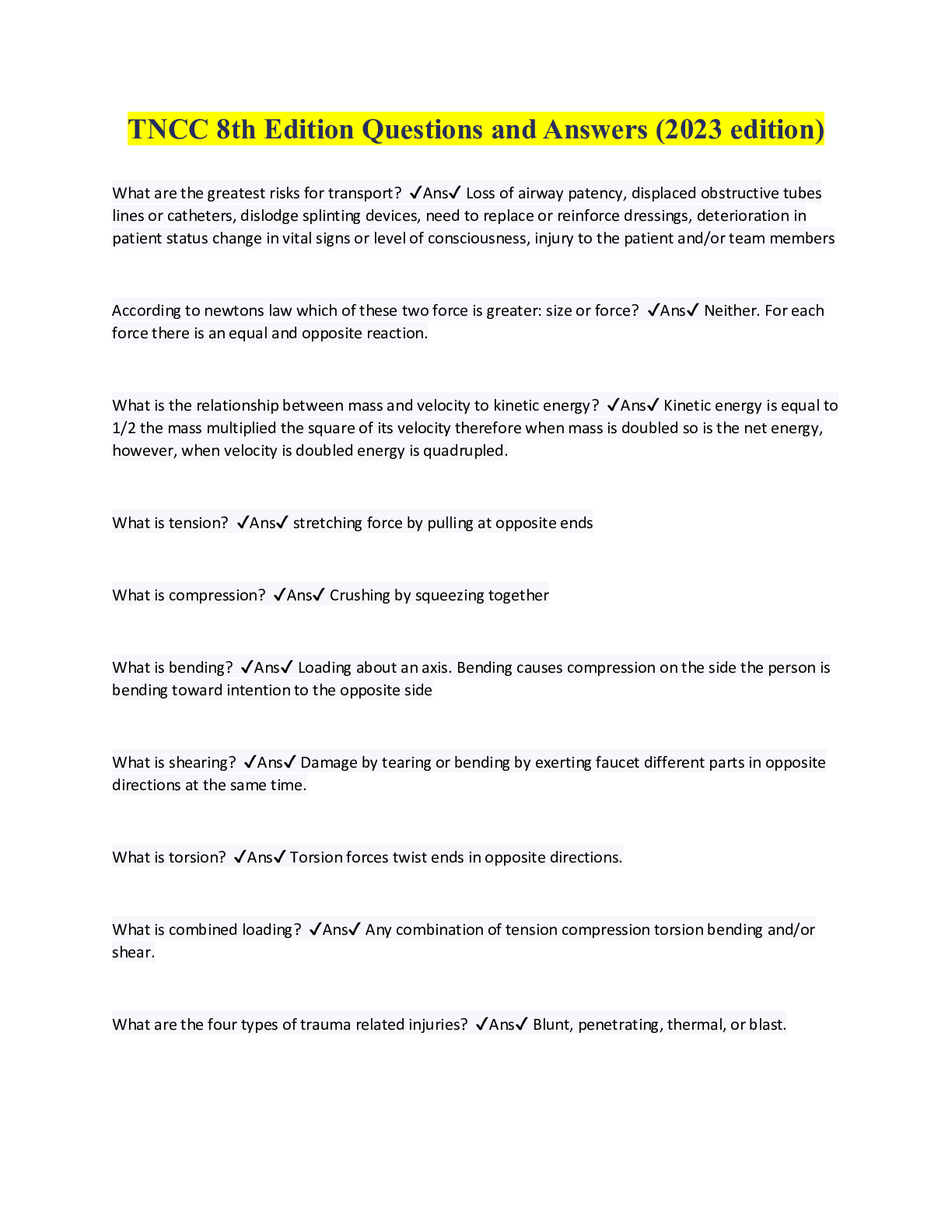

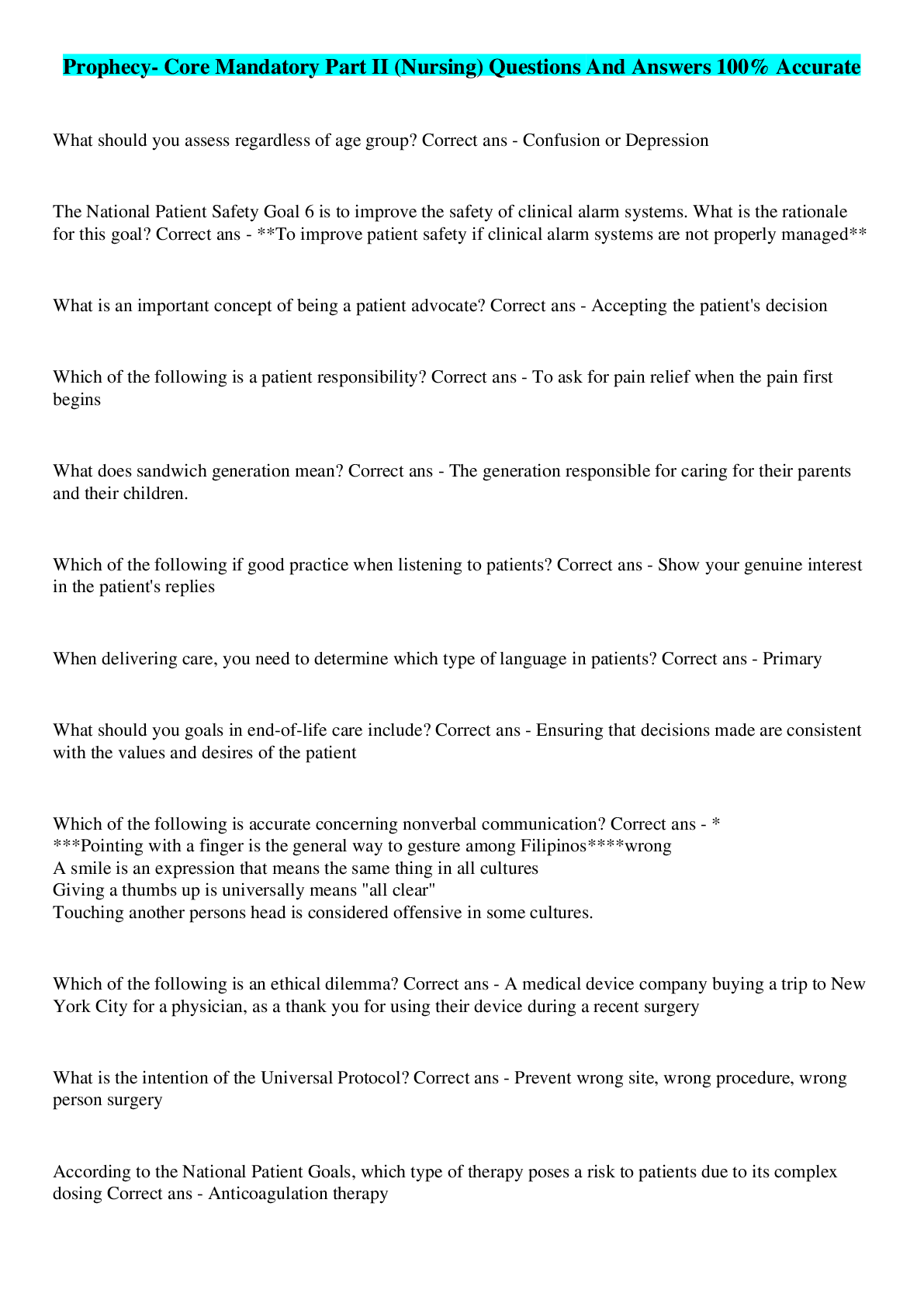

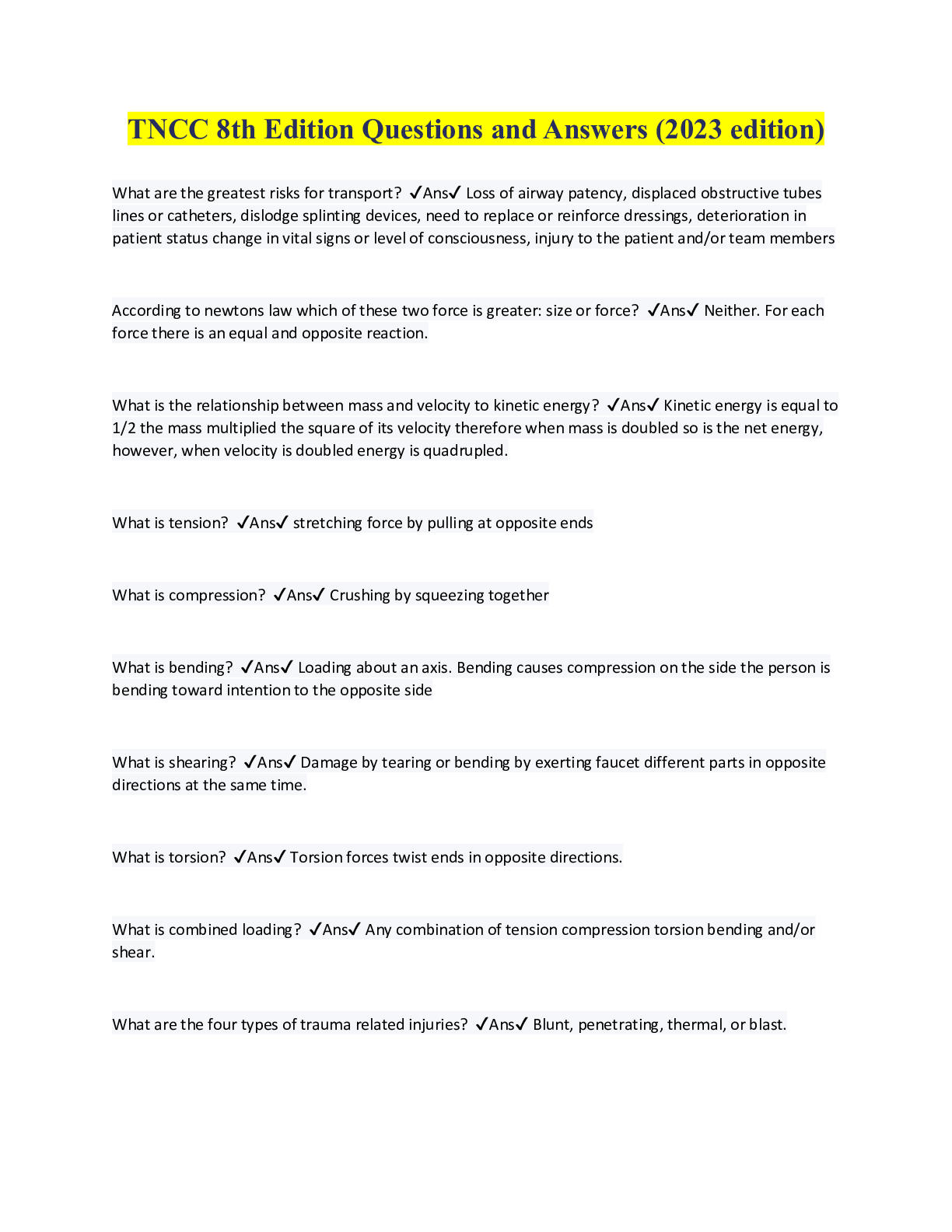
.png)
